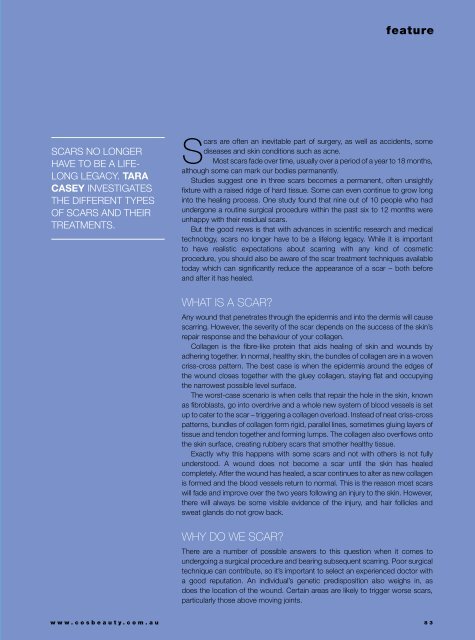Cosmetic Surgery and Beauty Magazine #68
Create successful ePaper yourself
Turn your PDF publications into a flip-book with our unique Google optimized e-Paper software.
feature<br />
Scars no longer<br />
have to be a lifelong<br />
legacy. Tara<br />
Casey investigates<br />
the different types<br />
of scars <strong>and</strong> their<br />
treatments.<br />
Scars are often an inevitable part of surgery, as well as accidents, some<br />
diseases <strong>and</strong> skin conditions such as acne.<br />
Most scars fade over time, usually over a period of a year to 18 months,<br />
although some can mark our bodies permanently.<br />
Studies suggest one in three scars becomes a permanent, often unsightly<br />
fixture with a raised ridge of hard tissue. Some can even continue to grow long<br />
into the healing process. One study found that nine out of 10 people who had<br />
undergone a routine surgical procedure within the past six to 12 months were<br />
unhappy with their residual scars.<br />
But the good news is that with advances in scientific research <strong>and</strong> medical<br />
technology, scars no longer have to be a lifelong legacy. While it is important<br />
to have realistic expectations about scarring with any kind of cosmetic<br />
procedure, you should also be aware of the scar treatment techniques available<br />
today which can significantly reduce the appearance of a scar – both before<br />
<strong>and</strong> after it has healed.<br />
What is a scar?<br />
Any wound that penetrates through the epidermis <strong>and</strong> into the dermis will cause<br />
scarring. However, the severity of the scar depends on the success of the skin’s<br />
repair response <strong>and</strong> the behaviour of your collagen.<br />
Collagen is the fibre-like protein that aids healing of skin <strong>and</strong> wounds by<br />
adhering together. In normal, healthy skin, the bundles of collagen are in a woven<br />
criss-cross pattern. The best case is when the epidermis around the edges of<br />
the wound closes together with the gluey collagen, staying flat <strong>and</strong> occupying<br />
the narrowest possible level surface.<br />
The worst-case scenario is when cells that repair the hole in the skin, known<br />
as fibroblasts, go into overdrive <strong>and</strong> a whole new system of blood vessels is set<br />
up to cater to the scar – triggering a collagen overload. Instead of neat criss-cross<br />
patterns, bundles of collagen form rigid, parallel lines, sometimes gluing layers of<br />
tissue <strong>and</strong> tendon together <strong>and</strong> forming lumps. The collagen also overflows onto<br />
the skin surface, creating rubbery scars that smother healthy tissue.<br />
Exactly why this happens with some scars <strong>and</strong> not with others is not fully<br />
understood. A wound does not become a scar until the skin has healed<br />
completely. After the wound has healed, a scar continues to alter as new collagen<br />
is formed <strong>and</strong> the blood vessels return to normal. This is the reason most scars<br />
will fade <strong>and</strong> improve over the two years following an injury to the skin. However,<br />
there will always be some visible evidence of the injury, <strong>and</strong> hair follicles <strong>and</strong><br />
sweat gl<strong>and</strong>s do not grow back.<br />
Why do we scar?<br />
There are a number of possible answers to this question when it comes to<br />
undergoing a surgical procedure <strong>and</strong> bearing subsequent scarring. Poor surgical<br />
technique can contribute, so it’s important to select an experienced doctor with<br />
a good reputation. An individual’s genetic predisposition also weighs in, as<br />
does the location of the wound. Certain areas are likely to trigger worse scars,<br />
particularly those above moving joints.<br />
www.cosbeauty.com.au 83


















